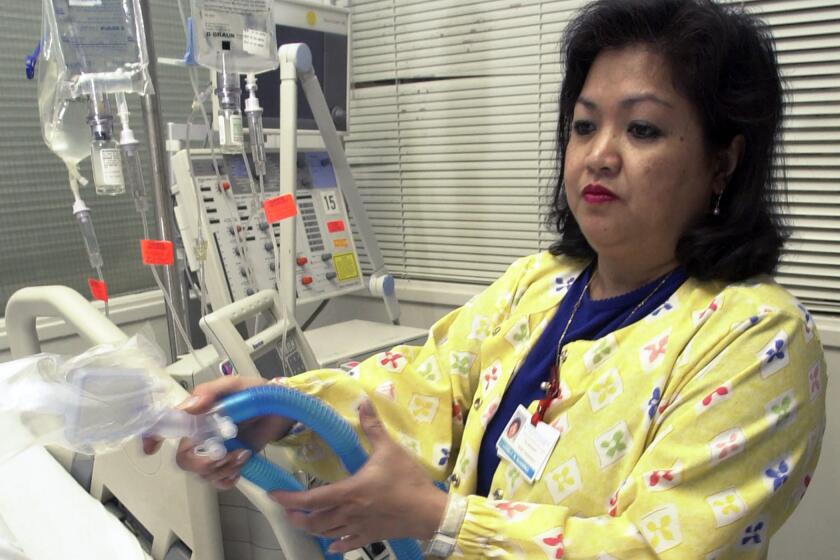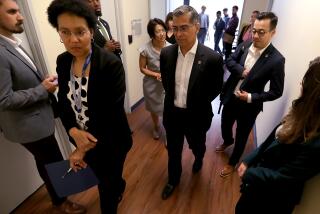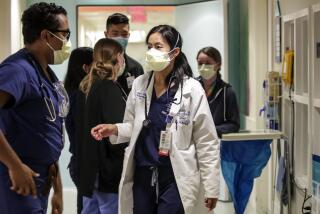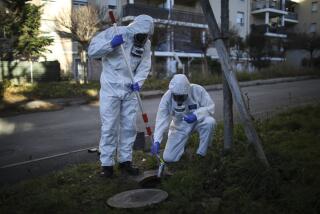First government report on coronavirus crisis confirms U.S. hospitals face dire problems

WASHINGTON â The first government report on the state of the nationâs hospitals amid the coronavirus pandemic has confirmed that they are facing severe shortages of tests, critical protective gear and the staff needed to treat and protect both patients and healthcare workers.
The 34-page report released Monday was based on hundreds of interviews of administrators at 323 medical centers coast to coast from March 23 to 27. It largely validated reports from news organizations, and painted a far more dire picture than the one President Trump describes at his daily news conferences.
Later, at Mondayâs briefing, he angrily dismissed questions about the report, which was from the inspector general for the Department of Health and Human Services. âGive me the name of the inspector general,â he challenged one reporter. âCould politics be entered into that?â Last week he fired another inspector general, for the intelligence agencies in retaliation for his role in events that led to Trumpâs impeachment.
The health departmentâs inspector general found that hospital administrators were particularly frustrated by the lack of testing. They complained that scarce resources, especially protective equipment, had to be used for patients simply suspected of having the virus because doctors had to treat them as if they were infected.
âThe sooner the hospital knows whether patients are negative, the faster it can move them to a lower level of care that consumes fewer resources,â one administrator told the government investigators.
Extended stays by patients awaiting test results were also depleting stores of protective gear. One hospital reported churning through through 307 masks daily for just 23 patients. Another medical center, the report said, was using 2,000 masks a day â a tenfold increase from before the outbreak.
Administrators said they were not only running short of masks and gowns but also supplies such as thermometers, disinfectants and and hand sanitizer. They were particularly concerned they would not have enough ventilators, a key tool in treating the sickest coronavirus patients.
At the time of the governmentâs interviews, some administrators noted they had not received any medical equipment from the federal governmentâs Strategic National Stockpile. Another reported receiving equipment but said it âwonât even last a day.â An official for a health system said it had received just 1,000 masks, half of which were for children and did not fit the staff.
Despite President Trumpâs assurances, the federal stockpile of equipment like ventilators is for local crises and likely canât meet coronavirus demand.
Unable to obtain critical gear from federal or state stockpiles, hospitals were competing with one another in the market and relying on unproved suppliers who did not always deliver what was promised, administrators said, and prices skyrocketed. âWe are all competing for the same items and there are only so many people on the other end of the supply chain,â one administrator told investigators.
Administrators expressed concern that they would face serious staffing shortages. âSeveral hospitals reported that they would struggle to maintain hospital operations if even a few staff were exposed to the virus,â the report said.
Nearly 20% of Americans are served by small rural hospitals that were already being stretched thin before COVID-19.
Already some administrators said they did not have enough specialists to treat the sickest patients. Even if their hospitals received enough ventilators, they did not have enough doctors and nurses to operate them. âYou can build thousands of ventilators,â an administrator said, âbut you need an army to manage that equipment and care for those patients.â
Administrators complained of inconsistent guidance from federal and state public health officials, and said that, as a result, they were wasting time educating the public about the threat of the virus. âThe misinformation that is out there, and the lack of serious understanding about what we could be facing, is extraordinary,â one administrator said.
The virus also was hurting hospitalsâ financial well-being, administrators said, as they were forced to cut back on elective procedures to treat coronavirus patients.
âHospitals reported that their most significant challenges centered on testing and caring for patients with known or suspected COVID-19 and keeping staff safe,â the report said. âHospitals also reported substantial challenges maintaining or expanding their facilitiesâ capacity to treat patients.â
The overall assessment was sharply at odds with the daily status reports from Trump. He and Vice President Mike Pence, the head of the presidentâs coronavirus task force, have given daily, upbeat reports on how many masks, gloves and ventilators the federal government has distributed to hospitals.
Over the weekend, the president claimed that âmany hospital administrators that weâve been in touch with, even in the really hot spots â you know what they are â are communicating directly with us that their level of supplies are meeting essential needs.â He added, âAt the current time, theyâre really thrilled to be where they are.â
Trump repeatedly has suggested without evidence that states and hospitals were actually to blame for not having enough ventilators. He blamed some hospital workers for a shortage of masks, suggesting personnel were hoarding or stealing them. âSomethingâs going on. And you ought to look into it as reporters. Where are the masks going? Are they going out the back door?â he said March 29. âAnd we have that happening in numerous places ⌠I donât think itâs hoarding. I think maybe itâs worse than hoarding.â
The inspector generalâs report came days after Trump informed Congress he was firing Michael Atkinson, the inspector general for the intelligence community. Atkinson last year disclosed to Congress, as required, a whistleblowerâs complaint about the presidentâs dealings with Ukraine, which led to Trumpâs impeachment.
Most federal agencies have inspectors general to act as independent watchdogs to audit and investigate their operations. The inspector generalâs office for the Department of Health and Human Services has been led since January by Christi Grimm, the principal deputy inspector general. The department has not had a Senate-confirmed inspector general since 15-year veteran Daniel Levinson stepped down in May.
More to Read
Get the L.A. Times Politics newsletter
Deeply reported insights into legislation, politics and policy from Sacramento, Washington and beyond. In your inbox three times per week.
You may occasionally receive promotional content from the Los Angeles Times.












